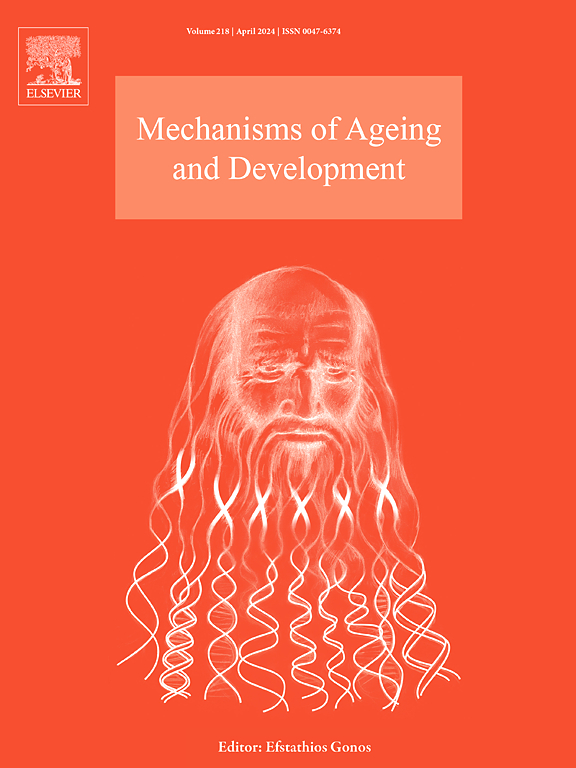ANRIL通过sasp驱动的miR146a调控年龄相关血管功能障碍,调节内皮细胞衰老和血管生成
IF 5.1
3区 医学
Q2 CELL BIOLOGY
引用次数: 0
摘要
血管老化,以内皮细胞(EC)功能障碍和血管生成受损为标志,是与年龄相关的缺血性疾病的主要驱动因素。尽管lncrna已经成为内皮功能的关键调节因子,但它们在内皮细胞衰老中的具体作用仍然是谜。在这项研究中,我们发现lncRNA ANRIL是衰老过程中内皮功能障碍的重要调节剂。通过分析公开的lncRNA测序数据集,比较年轻和老年ECs,我们确定了ANRIL,并通过人类脐静脉ECs (HUVECs)的复制衰老模型和老年小鼠骨骼肌ECs的FACS分选验证了其作用。虽然ANRIL对血管生成的直接影响很小,但功能分析和转录组学分析显示其对衰老相关分泌表型(SASP)有深远的影响。值得注意的是,ANRIL调节内皮细胞中miR146a的表达,并将其转移到巨噬细胞,在巨噬细胞中抑制VEGF分泌并破坏内皮新生血管。在小鼠后肢缺血模型中,ANRIL下调可显著增强新生血管和恢复血流,揭示其对缺血性疾病的治疗潜力。这些发现将ANRIL定位为内皮细胞衰老的新型有效调节剂,为血管衰老的分子基础提供了新的见解,并表明ANRIL是缓解年龄相关血管功能障碍的有希望的治疗靶点。本文章由计算机程序翻译,如有差异,请以英文原文为准。
ANRIL modulates endothelial senescence and angiogenesis through SASP-driven miR146a regulation in age-related vascular dysfunction
Vascular aging, marked by endothelial cell (EC) dysfunction and compromised angiogenesis, is a central driver of age-related ischemic diseases. Although lncRNAs have emerged as pivotal regulators of endothelial function, their specific roles in endothelial aging remain enigmatic. In this study, we identify the lncRNA ANRIL as a crucial modulator of endothelial dysfunction during aging. By analyzing publicly available lncRNA sequencing datasets comparing young and old ECs, we pinpointed ANRIL and validated its role through a replicative senescence model in human umbilical vein ECs (HUVECs) and FACS sorting of skeletal muscle ECs from aged mice. While ANRIL showed minimal direct effects on angiogenesis, functional assays and transcriptomic analysis revealed its profound impact on the senescence-associated secretory phenotype (SASP). Remarkably, ANRIL regulates the expression of miR146a in ECs, which is transferred to macrophages, where it inhibits VEGF secretion and disrupts endothelial neovascularization. In vivo, ANRIL downregulation in a murine hindlimb ischemia model significantly enhanced neovascularization and restored blood flow, revealing its therapeutic potential for ischemic diseases. These findings position ANRIL as a novel, potent regulator of endothelial senescence, offering new insights into the molecular basis of vascular aging and suggesting ANRIL as a promising therapeutic target to mitigate age-related vascular dysfunction.
求助全文
通过发布文献求助,成功后即可免费获取论文全文。
去求助
来源期刊
CiteScore
11.10
自引率
1.90%
发文量
79
审稿时长
32 days
期刊介绍:
Mechanisms of Ageing and Development is a multidisciplinary journal aimed at revealing the molecular, biochemical and biological mechanisms that underlie the processes of aging and development in various species as well as of age-associated diseases. Emphasis is placed on investigations that delineate the contribution of macromolecular damage and cytotoxicity, genetic programs, epigenetics and genetic instability, mitochondrial function, alterations of metabolism and innovative anti-aging approaches. For all of the mentioned studies it is necessary to address the underlying mechanisms.
Mechanisms of Ageing and Development publishes original research, review and mini-review articles. The journal also publishes Special Issues that focus on emerging research areas. Special issues may include all types of articles following peered review. Proposals should be sent directly to the Editor-in-Chief.

 求助内容:
求助内容: 应助结果提醒方式:
应助结果提醒方式:


